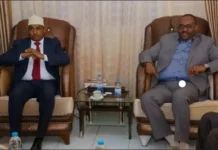Baidoa – IOM has started the relocation of Internally Displaced Persons (IDPs) who were at risk of eviction to the newly developed public site in Baidoa.
Some 682 households, consisting of 3,914 individuals drawn from 12 out of 15 targeted IDP sites have been relocated to the new Baidoa public site as of 23 June, one week after relocation began. The effort will support internally displaced persons with better living conditions and sustainable land tenure. The relocation, expected to continue until July, will benefit over 1,000 households from 15 IDP sites.
In the months leading up to the relocation, IOM had developed the new public site together with the South West State authorities, the Baidoa municipality and the community.
“We recognize the rights of IDPs and Displacement Affected Communities (DACs) to own land and solve recurring problems such as evictions,” said Abdullahi Ali Watiin, the Mayor of Baidoa.
He added: “Our vision is to make sure that all our community members, regardless of their status, live on a decent protected land, without discrimination or fear of eviction.”
The city of Baidoa, in Somalia’s southwestern Bay region, hosts an estimated 323,000 displaced people, many of whom live on private land without secure tenure agreements. They are at constant risk of forced evictions.
The relocation project is a multi-sectoral integrated response from IOM’s emergency and durable solutions divisions. This approach focuses on addressing the immediate needs of the vulnerable IDPs at risk of eviction through solutions that are integrated in the long-term urban expansion plan of Baidoa City. Among others, the site planning has been coordinated with UN-Habitat to ensure that future and under-construction roads are incorporated and that the land allocated to IDPs meets long-term standards rather than recreating a camp-like setting.
To date, IOM has constructed 500 latrines and a sustainable water supply system including two elevated water tanks that will provide clean and safe water to the nearly 1,000 households.
In addition, two police stations have been constructed along with solar streetlights to enhance safety and security. Main roads leading to the nearest markets were also cleared for easy access and linkage with the host communities. The site plan also allows space for markets, community centres, and common service areas.
Aside from being provided with plots, the households also received vouchers to help them construct shelters of their choice. Through these vouchers, they can acquire the shelter materials that they need from selected vendors. The relocating households also received training from IOM on how to construct shelters, as well as to build shelters for 40 vulnerable households.
Rainer Palau Gonzalez, IOM’s Senior Programme Coordinator said, “The relocation is going according to schedule after months of preparation with the government and other partners. We will monitor the coming months carefully to ensure that the needs of the relocated households are met.”
“This has been a critical project in line with the Humanitarian-Development Nexus, which combines emergency humanitarian response with laying the foundations for durable solutions and development. Our partners, DFID, ECHO, JSB and OFDA, have been essential in supporting our project activities. We are very happy to finally be able to welcome the IDPs, especially those at risk of eviction, to this new site,” Gonzalez added.
In the coming weeks, IOM and other stakeholders will continue the relocation of the families at risk of eviction and provide them with all the support they need.
IOM






































